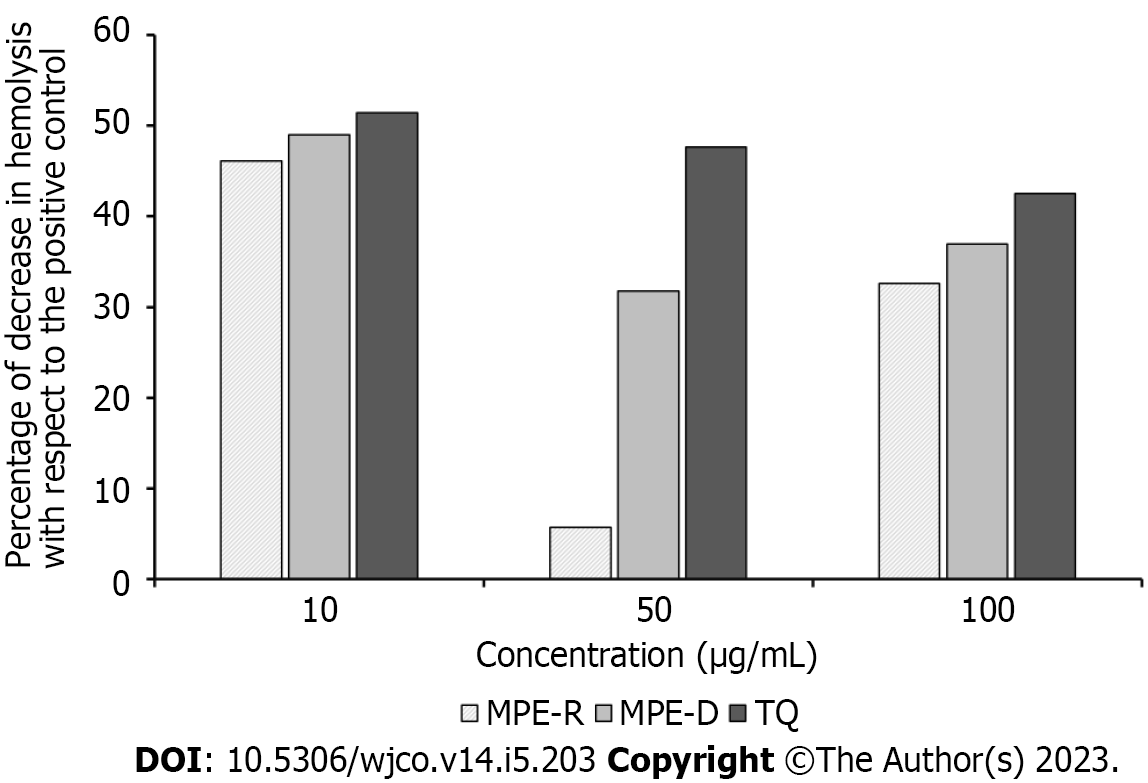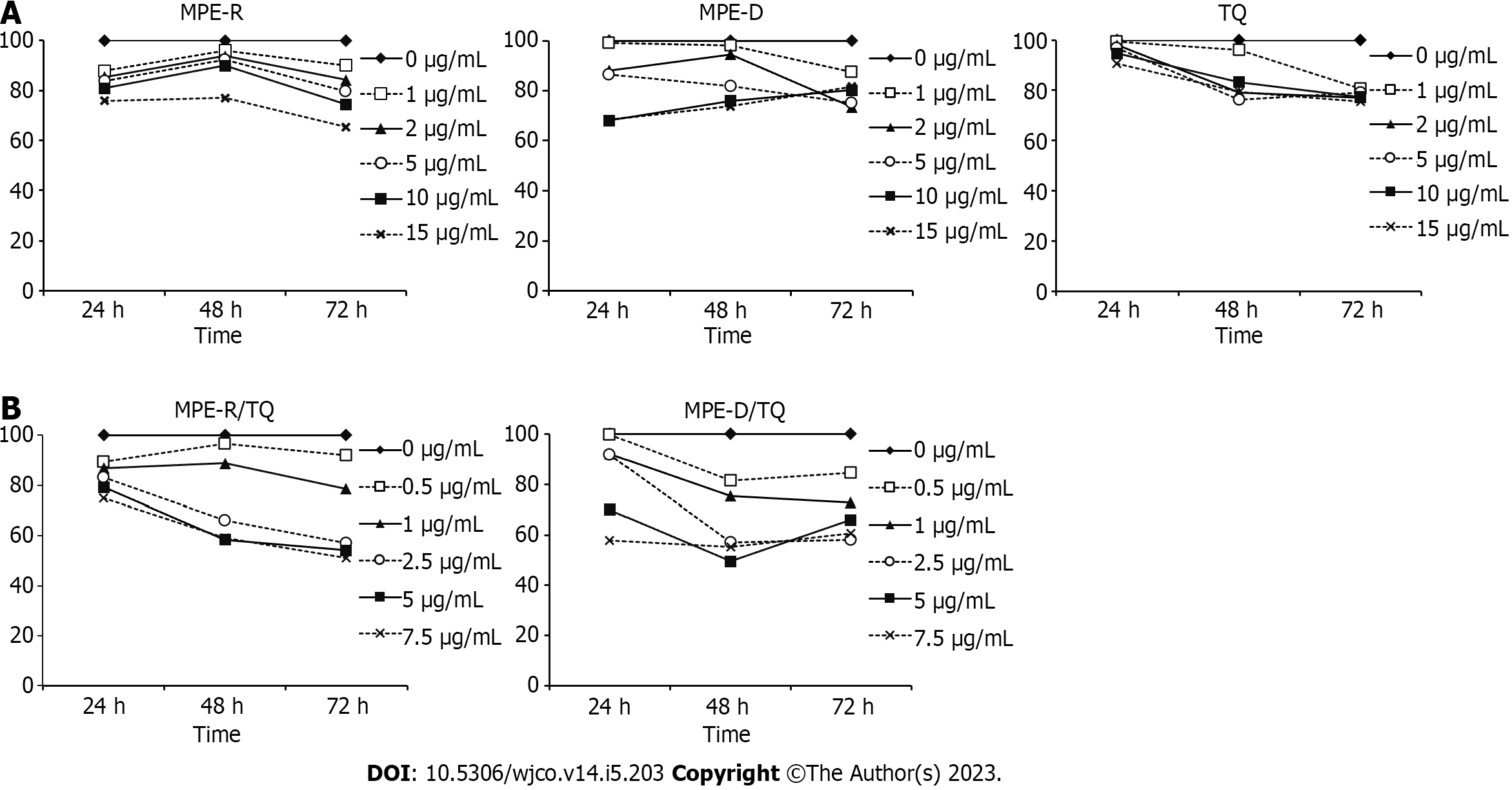Copyright
©The Author(s) 2023.
World J Clin Oncol. May 24, 2023; 14(5): 203-214
Published online May 24, 2023. doi: 10.5306/wjco.v14.i5.203
Published online May 24, 2023. doi: 10.5306/wjco.v14.i5.203
Figure 1 2,2-diphenyl-1-picrylhydrazyl free radical scavenging activity of methanol propolis extract alone or in combination with Thymoquinone.
A: 2,2-diphenyl-1-picrylhydrazyl (DPPH) free radical scavenging activity of each of methanol propolis extract from Rashaya (MPE-R) and from Akkar-Danniyeh (MPE-D; 20-100 µg/mL) alone; B: DPPH free radical scavenging activity of each of MPE-R and MPE-D (10-50 µg/mL) in combination with Thymoquinone (TQ; 12.5-100 µg/mL). The samples were mixed with DPPH and the absorbance of the mixture was measured after 30 min. The values are expressed as percentage of DPPH percentage inhibition relative to the control. Each value represents the mean ± SD of n = 2 experiments. aP < 0.05 and bP < 0.01 are significantly different from control using two-tailed Student's t-test.
Figure 2 Invitro antihemolytic/cytoprotective activity of each of Thymoquinone and methanol propolis extract from Rashaya and Akkar-Danniyeh against H2O2- induced oxidative hemolysis.
Human red blood cells suspension was preincubated with methanol propolis extract from Rashaya (MPE-R), methanol propolis extract from Akkar-Danniyeh (MPE-D), or Thymoquinone (TQ; 10-100 µg/mL) for 5 min. The cell suspension was then incubated with 10% H2O2 for 90 min at 37°C. The samples were then centrifuged, and the absorbance of the supernatant was measured. The values are expressed as percentage of decrease in hemolysis with respect to the positive control (10 % H2O2). Each value is obtained from n = 1 experiment performed in monoplicate.
Figure 3 Invitro hemolytic activity of each of methanol propolis extract from Rashaya and Akkar-Danniyeh alone or in combination with Thymoquinone.
A: Hemolytic activity of each of methanol propolis extract from Rashaya (MPE-R) and methanol propolis extract from Akkar-Danniyeh (MPE-D; 10-200 µg/mL) and Thymoquinone (TQ; 20-100 µg/mL); B: hemolytic activity of the combination of MPE- R or- D (5-100 µg/mL) and TQ (10-50 µg/mL). Washed fresh human blood was incubated with the natural products for 90 min. The samples were then centrifuged, and the absorbance of the supernatant was measured. The values are expressed as percentages of red blood cells hemolysis with respect to the positive control (SDS 1%). Each value represents the mean ± SD of n = 3 experiments for MPE-R and MPE-D single treatments and n = 1 for TQ single treatment and combination treatments. cP < 0.0001 is significantly different from positive control using two-tailed Student's t-test.
Figure 4 Anticancer activity of Thymoquinone and methanol propolis extract from Rashaya and Akkar-Danniyeh against MDA-MB-231 human breast cancer cells.
A: Cells were treated with each of methanol propolis extract from Rashaya (MPE-R), methanol propolis extract from Akkar-Danniyeh (MPE-D) and Thymoquinone (TQ; 0-15 µg/mL) alone for 24, 48 and 72 h; B: Cells were treated with the combination of each of MPEs (0-7.5 µg/mL) with TQ (0-7.5 µg/mL) for the same time point. Cell viability was then determined using MTT assay. The values are expressed as percentage of viable cells relative to untreated control. Each value represents the mean ± SD of n = 1 experiment performed in duplicates.
Figure 5 Anticancer activity of Thymoquinone and methanol propolis extract from Rashaya and Akkar-Danniyeh against HCT-116 human colorectal cancer cells.
A: Cells were treated with each of methanol propolis extract from Rashaya (MPE–R), methanol propolis extract from Akkar-Danniyeh (MPE-D) and Thymoquinone (TQ; 0-15 µg/mL) alone for 24, 48 and 72 h; B: Cells were treated with the combination of each of MPEs (0-7.5 µg/mL) with TQ (0-7.5 µg/mL) for the same time point. Cell viability was then determined using MTT assay. The values are expressed as percentage of viable cells relative to untreated control. Each value represents the mean ± SD of n = 1 experiment performed in duplicates.
- Citation: AlDreini S, Fatfat Z, Abou Ibrahim N, Fatfat M, Gali-Muhtasib H, Khalife H. Thymoquinone enhances the antioxidant and anticancer activity of Lebanese propolis. World J Clin Oncol 2023; 14(5): 203-214
- URL: https://www.wjgnet.com/2218-4333/full/v14/i5/203.htm
- DOI: https://dx.doi.org/10.5306/wjco.v14.i5.203













